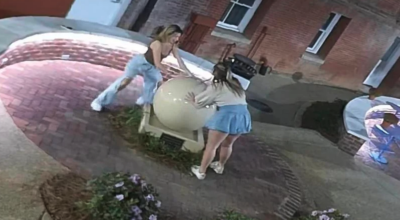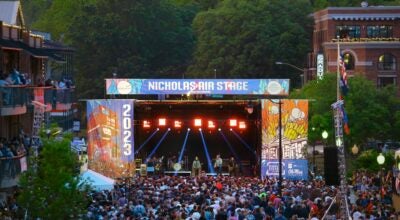City holds public hearing for Downtown District
Published 10:30 am Wednesday, June 20, 2018
The City Hall courtroom was filled to capacity, with audience members spilling into the halls, during Tuesday’s meeting of the Oxford Board of Aldermen.
The crowd gathered for the second reading and public hearing for the proposed Downtown District. As the ordinance is currently written, the Downtown District would span across two blocks of the west side of the Square, down Van Buren Avenue, South 10th Street and East Jackson Avenue. Only businesses with a liquor license or beer and light wine permit would be affected.
According to Mayor Robyn Tannehill, the ordinance is not a response to one isolated incident, with discussions about public safety on the Square going back as early as 2008 and August of 2017. While providing security camera footage of a crowded Square, Tannehill referred to the issue as a “ticking time bomb,” saying the aldermen had watched the issue for quite some time and needed to take decisive action.
“We have come to a point in time when we want to make a positive change. These numbers of people come with both a blessing and challenges,” Tannehill said. “I’ve been reminded quite a few times over the past five days that doing what’s right is not always popular and doing what’s popular is not always right.”
Tannehill stressed that the motive of the aldermen and Oxford Police Department was not to “put the hammer down” on entertainment venues and bars, but work with them to provide a safe environment.
OPD Chief Joey East facilitated the second reading of the ordinance, explaining the thought process behind each change in the latest draft. One of the major changes, East said, was eliminating language that gave the police department the authority to deny requests for events from designated “event venues.” Within the current boundaries of the proposed ordinance, the Lyric is the only business that falls into that category.
Other language that was altered in the ordinance was the change of required “ID Scanners” to “Electronic Age Verification Devices,” which implies the scanners will be used only to verify a patron’s age in businesses with age-restricted entry, or restaurants that serve alcohol. The use of ID scanners, according to East, will serve as a deterrent to underage drinkers. A previous draft of the ordinance gave OPD the right to make a lawful request for the data to assist in investigations, should a crime take place near the business. Under that draft, the businesses would have been required to store patrons’ information for 14 days.
“I’ve been here a long time and served on enough task forces to know we have an underage drinking problem,” East said. “Mayor Howorth explained it, saying ‘We have a culture of alcohol here.’ I think this is a good step the city is taking in this measure to at least lay a foundation and say, we care and we’re trying to do something about it.”
Owners, bartenders and managers from several of the 11 Square businesses affected by the proposed ordinance were in attendance, expressing their concerns about the use of ID scanners to verify customer ages.
Hudson Chadwick, owner of Rafters and the Annex on East Jackson Avenue, addressed the aldermen during the public hearing, saying he was in full support of increasing security measures and ensuring public safety. However, Chadwick also said he took an issue with the cost of such measures, especially ID scanners.
A quality ID scanner, Chadwick explained, could cost upward of $1,800. Spending that amount on a scanner for entrance, he said, could negatively impact a business. He also added that many fake ID cards are almost impossible to distinguish and can circumvent ID scanners. Chadwick presented alternative solutions to the ID scanners, which he said were the result of conversations with Alcoholic Beverage Control officers who had encountered underage drinkers with fake IDs.
“We’re in a situation where the ID market has gotten so out of control. I’ll be 100 percent honest, ABC came into our place the other day and wrote several minor in possession [tickets],” Chadwick said. “I talked to the agents and asked what we could have done better, and they looked at us and didn’t really have a solution. The scanners may make everybody feel better, but I don’t think it actually solves the problem.”
Chadwick added that, in his experience and per conversations with ABC, scanners are not as effective as a well-trained person who knows how to detect a fake ID and use well-composed questions. One example Chadwick gave was asking a suspected fake ID user questions, like what county they’re from, instead of asking them to simply repeat a false address that could be easily memorized.
Other issues raised by bar personnel concerned methods for training staff to handle crisis situations, required storage of employee information and the geographic boundaries of the proposed district. Tannehill addressed the expansion of the Downtown District Boundaries, saying the city would be open to discussing the possibility.
“The board is going to look into expanding that district to include either the overall Square Business District, which goes from Chevron to Chevron and from Saint Peter’s Church to City Hall,” she said. “Or, it would apply to all businesses with state liquor licenses and city-issued beer and light wine permit holders.”
The reading and hearing lasted approximately two and a half hours. After each member of the public who desired to speak did so, the board of aldermen determined the need for another public hearing, more revisions and a third reading of the proposed ordinance.
Above all, Tannehill said she and the board welcome public input, and want the ordinance to be good for everyone affected. Treating the proposed ordinance as a working document, she said, is the best way to achieve that.
“We all know that Oxford, Mississippi is a place where you can come and walk around the Square with your family, and go to bars and be there at closing time and be in a safe environment,” Tannehill said. “At Beale Street, they make you pay to be on the street, or at Bourbon Street there are areas where you have to go through security. That’s exactly what this board does not want. We want to do what it takes to prevent getting to that point. We want to do what it takes to provide a safe environment for people to go out and eat and drink and enjoy themselves.”
A public hearing at the Oxford Conference Center and a third reading of the ordinance will be held on a date to be determined.
To read the proposed ordinance, click here.





